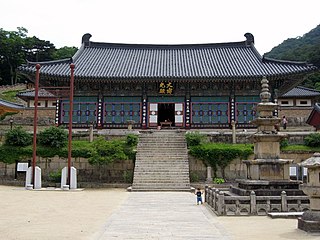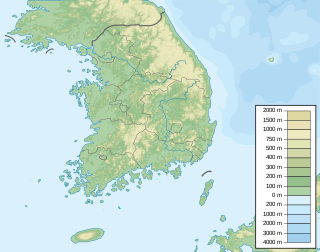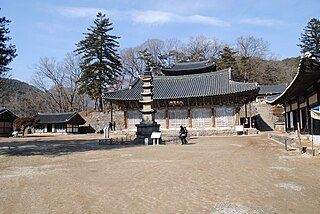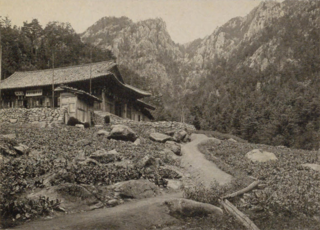
Haeinsa is a head temple of the Jogye Order of Korean Seon Buddhism in Gayasan National Park, South Gyeongsang Province, South Korea. Haeinsa is most notable for being the home of the Tripitaka Koreana, the whole of the Buddhist Scriptures carved onto 81,350 wooden printing blocks, which it has housed since 1398.
Buddhist temples are an important part of the Korean landscape. This article gives a brief overview of Korean Buddhism, then describes some of the more important temples in Korea. Most Korean temples have names ending in -sa, which means "temple" in Sino-Korean.

Bulguksa is located on the slopes of Mount Toham. It is a head temple of the Jogye Order of Korean Buddhism and encompasses six National treasures of South Korea, including the Dabotap and Seokgatap stone pagodas, Cheongun-gyo, and two gilt-bronze statues of Buddha. The temple is classified as Historic and Scenic Site No. 1 by the South Korean government. In 1995, Bulguksa was added to the UNESCO World Heritage List together with the Seokguram Grotto, which lies four kilometers to the east.

Tongdosa is a head temple of the Jogye Order of Korean Buddhism and in the southern part of Mt. Chiseosan near Yangsan, South Gyeongsang Province, South Korea.

Pohyon-sa is a Korean Buddhist temple located in Hyangsan county in North Pyong'an Province, North Korea. It is located within the Myohyang Mountains. Founded under the Koryo dynasty at the start of the 11th century, the temple flourished as one of the greatest centers of Buddhism in the north of Korea, and became a renowned place of pilgrimage. Like most other temples in North Korea, the complex suffered extensive damage from US bombing during the Korean War. The temple is designated as National Treasure #40 in North Korea, with many of its component buildings and structures further declared as individual national treasures.

Jikjisa is a head temple of the Jogye Order of Seon Buddhism. It is located on the slopes of Hwangaksan in Daehang-myeon, Gimcheon, North Gyeongsang Province, South Korea. It may be one of the oldest temples in South Korea.

Magoksa is a head temple of the Jogye Order of Korean Buddhism in Gongju, South Korea. It is located on the eastern slope of Taehwasan, on taegeuk-shaped bend in the Taegeukcheon Stream.

Beopjusa is a head temple of the Jogye Order of Korean Buddhism. It is situated on the slopes of Songnisan, within Songnisan National Park, in Naesongni-myeon, Boeun County, in the province of Chungcheongbuk-do, South Korea.

Geumsansa is a temple of the Jogye Order of Korean Buddhism standing on the slopes of Moaksan in Gimje City, Jeollabuk-do, South Korea.
Oseam or Oseam Temple is a small Korean Buddhist temple located in the area of Mangyeongdae Pavilion, Mount Seorak, Gangwon Province, South Korea. It is an annex of Baekdamsa Temple which is the head temple of the third district in the Jogye Order.

Naksansa or Naksan Temple is a Korean Buddhist temple complex in the Jogye order of Korean Buddhism that stands on the slopes of Naksan Mountain. It is located about midway between Sokcho and Yangyang, Gangwon Province, eastern region of South Korea. Naksansa is one of the few temples in Korea to overlook the Sea of Japan.

Sŏgwang-sa is a Korean Buddhist temple located in Sŏlbong-ri in Kosan County, Kangwon Province, North Korea. Once one of Korea's largest Buddhist temples, the complex was mostly destroyed by US bombing in 1951, and today it lies in ruins; however, it is slated to be reconstructed in coming years. It is listed as National Treasure #94
Ryeongtongsa is a Korean Buddhist temple located on Ogwansan in Kaesong, North Korea.

Bongjeongsa is a Korean Buddhist temple on the slopes of Mount Cheondeung in Andong city, North Gyeongsang Province, South Korea. It is a subsidiary temple of Gounsa, the head temple of the 16th branch of Jogye Order.

Yŏngmyŏng Temple was a Korean Buddhist temple located at the foot of Moranbong hill in Pyongyang, North Korea. Prior to its destruction in the Korean War, it was the largest and most important center of Buddhist worship in that city. Though it is unknown when the temple was founded, popular tales date it to the end of the Goguryeo kingdom. The temple was completely rebuilt under the Joseon dynasty. Under the Japanese occupation of Korea, the temple became a major tourist site in Pyongyang it was renowned for its beautiful riverside location and many cherry trees. In the 1920s it again underwent an extensive restoration funded by the Japanese government, who also officially changed its name to its Japanese pronunciation, "Eimei-ji". During that time, the temple was also confiscated from by the government, and given for use as a headquarters for the Rinzai sect of Japanese Zen Buddhism. The Rinzai monks were tasked with converting the citizens away from traditional Korean Buddhism as part of a government program to replace the old Korean culture with that of modern Japan.

P'yohun-sa is a Korean Buddhist temple located on Mount Kumgang, North Korea. Founded in the 7th century under the kingdom of Silla, it is the only one of Mount Kumgang's four great temples to have survived the Korean War. It is listed as the #97 National Treasures of North Korea.

Yujŏm-sa is a Korean Buddhist temple located on Mount Kumgang, North Korea. Founded under the kingdom of Silla, it underwent many successive restorations before being destroyed by American forces during the Korean War.

Geonbongsa is a temple located in Goseong County, Gangwon-do, South Korea.

Seonam Temple, or Seonamsa, is a Korean Buddhist temple on the eastern slope at the west end of Jogyesan Provincial Park, within the northern Seungjumyeon District of the city of Suncheon, South Jeolla Province, South Korea. It belongs to the Taego Order although the Jogye Order claims possession over it.

Mahayeon Hermitage was a Korean Buddhist hermitage, located at Naegeumgang-ri, Kumgang-gun, Kangwon-do, North Korea. This structure was located at an altitude of 846m, the highest point of the Manpok-dong Valley of Mount Geumgang and was a branch hermitage of the Yujomsa temple.


















